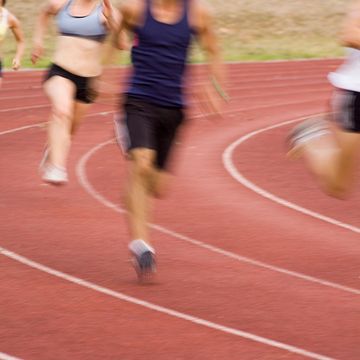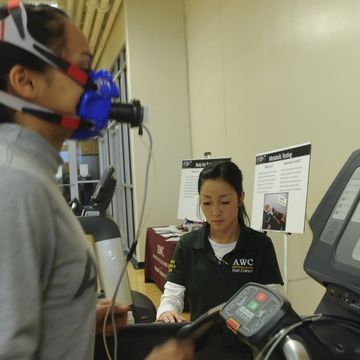How to Tap into the Benefits of Interval Training CA Notice at Collection on what it would take, physiologically speaking, for someone to run a sub-2-hour marathon. One of the riddles that emerged while reporting that piece was about the relationship between aerobic fitness (as expressed by VO2 max) and running economy (analogous to the gas mileage of your car).
Should Your Doctor Check Your VO2 Max, Michael Joyner pointed out that you should be able to make a good prediction for how fast someone can run a marathon based on knowing only their VO2 max, running economy, and lactate threshold. By some estimates, in fact, knowing just the VO2 max and running economy accounts for 94 percent of the variation in 10-mile run performance. The puzzle is that if you take "elite" values of VO2 max and running economy and plug them into the models, they predict that people should already be running sub-2 marathons.
So why aren't they? Because, for the most part, the people who have exceptional VO2 max have only middling to good running economy, while the people with exceptional running economy have only middling to good VO2 max. No one combines the best of both worlds. Now, this could be because exceptional values of any parameter are exceedingly rare, so it would take an extraordinary stroke of luck for someone to happen to be exceptional in both. Or, as Joyner pointed out in his 1991 paper, "it may be that high VO2 max values are incompatible with excellent running economy or lactate threshold values."
Could it be that there's something about being born with excellent VO2 max that predisposes you to be relatively inefficient? Since your muscles are always receiving plenty of oxygen, perhaps your muscle cells or gait don't come under as much pressure to maximize efficiency. Or, conversely, if you're born as a very efficient oxygen user, perhaps your oxygen delivery system doesn't get pushed quite as hard. Or perhaps, rather than a developmental issue, there's a more direct conflict between VO2 max and economy. For example, less efficient runners recruit a higher proportion of fast-twitch fibers, which demand higher oxygen usage.
That's a lot of hypotheticals. So what does the data show? Until recently, not much. But How to Boost Your VO PLoS ONE in April offers an interesting new look. Researcher Andrew Shaw and his colleagues from Loughborough University presented data from 168 highly trained distance runners (between 800 meters and marathon) who'd been tested in the English Institute of Sport labs over the years. Of these runners, 54 of them were tested multiple times, which allowed them to ask two related questions:
- Are people with high VO2 max any more or less likely to have high running economy than people with lower VO2 max?
- If you improve your VO2max over time, does that increase the chances that your running economy will get worse?
One key problem, the authors point out, is that VO2 max and running economy are presented relative to body mass—i.e. instead of saying that someone can use (for example) five liters of oxygen per minute, we generally say that they can use 70 milliliters of oxygen per kilogram of body mass per minute. This is a convenient way of making the numbers comparable between people of different sizes, but it's not perfect. After all, oxygen use doesn't scale perfectly with body size, since bodies are made up of bones and fat as well as oxygen-consuming muscle.
Anyway, the problem is that comparing two numbers (VO2 max and running economy) that are both divided by a third number (mass) can produce false correlations between them. To get around this, the study uses a statistical technique to eliminate the influence of body mass.
Scientists debate the relationship between aerobic fitness and running economy...
Here's a quick visual of the overall relationship between running economy (on the vertical axis) and VO2 max (on the horizontal axis) for the women in the study. (Check out the original article, freely available here, to see the men's data, which is similar.) Note that running economy is plotted so that "high" values are bad, meaning you're burning more energy to sustain a given pace.
CA Notice at Collection is an inverse relationship between VO2 max and running economy: those who are good in one are less likely to be good in the other. But it's a pretty scattered relationship. Overall, knowing someone's VO2 max accounts for only seven percent of the variance in their running economy. The rest is determined by other factors.
A similar picture emerges when you look at the longitudinal data:
Again, those who improved VO2 max were slightly less likely to improve running economy. In this case, knowing the change in VO2 max explained 12 percent of the variance in running economy changes.
So does this answer the original question? I'm not sure. According to the authors, "[t]he major contribution of this study to the field is that only a small to moderate association exists between RE and V̇O2max (R2 ~ 12%) when body mass is appropriately accounted for." They're emphasizing that this is not a strong link, which makes sense when you consider that VO2 max depends on things like cardiac output and hemoglobin mass, whereas running economy depends on totally different factors like stride biomechanics.
But for a sub-2 marathon, I think it's possible that these weak (7 to 12 percent) relationships could still be relevant. When you're talking about the chances of combining a one-in-a-million VO2 max and a one-in-a-million running economy in one person, even a slight inverse correlation could have an impact.
It's also worth wondering whether the strength of the correlation would be different in a more elite cohort. These athletes were, on average, at about 90 percent of the current British records, which suggests around 2:20 for a men's marathon. Perhaps 2:05 marathoners would be different.
From a practical training point of view, though, the message is simple. You can work on improving your VO2 max, and you can work on improving your running economy, and there shouldn't be much conflict between the two.
* * *
Read We earn a commission for products purchased through some links in this article, and follow the latest posts via Twitter, Facebook, RSS, or (new!) weekly email digest.












